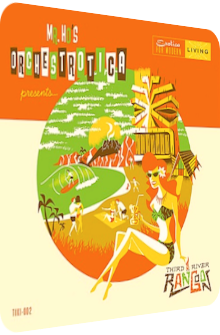
Mr. Ho's Orchestrotica
Third River Rangoon
2011
Here we are again with another album by Mr. Ho‘s Orchestrotica, called Third River Rangoon, which is the direct follow-up of the marvelous The Unforgettable Sounds Of Esquivel, but couldn‘t possibly be farther away stylistically. Bandleader Brian O‘Neill once more arranged the album and is responsible for its overarching concept. This time though, O‘Neill gives the majority of the 20+ members of his Big Band a rest and picks the three remaining instrumentalists to proceed with a new incarnation of Mr. Ho‘s Orchestrotica, a so-called third-stream quartet: Geni Skendo is the flutist responsible for surprisingly deep and vibrating tones, adding both deepness and lightness to the songs; Noriko Terada is the percussionist, a role she is sharing with Brian O‘Neill, and she finds the right balance between conspicuity and unobtrusiveness, the latter being more important in a Jazz quartet, the former being successfully proved by Terada in the Big Band formation of Mr. Ho‘s Orchestrotica; Jason Davis is the bassist and, as it usual in Jazz quartets, the counterpart of the instrumentalists who play in higher regions, especially the reverberating vibraphone which, finally, is played by Brian O‘Neill himself.
All of these musicians except O‘Neill (who played the piano on the Esquivel album) reprise their roles, and if you spotted occasional Polynesian textures or a vintage Exotica style on that Esquivel homage, it sure enough was conjured by these fellows. The quartet presents third-stream music, namely music that oscillates between artful Jazz and artificial setups, in this case the capture of the true spirit of faux-exotic music – the perfect motif of an Exotica album! And there‘s another positive thing worth mentioning: the wealth of original compositions by O‘Neill (a whopping 8 tracks out of 11), who therefore doesn‘t capture the past by solely imitating other artists‘ sounds, but in fact comes up with original compositions that are nothing short of beautiful and revive the most blissful Exotica days of the late 50‘s and early 60‘s in all their glory and in pitch-perfect sound quality.
As the cover artwork implies, this is relaxing music for holidays at the beach, but the compositions are better enjoyed at home, as their playfulness and dynamic improvisations can be savored best in calm moments. While Mr. Ho‘s Esquivel album is a hot-tempered affair with brass sections that are bubbling over with shimmering blasts, Third River Rangoon is on the opposite stylistic spectrum of Exotica music with its soothing, intimate vibraphone sounds and the strict omission of any brass instrument.
The first track which is called Third River Rangoon is an original piece by O‘Neill and doesn‘t waste time to get things going. It perfectly encompasses the third-stream thesis of the late 50‘s, as it is quite a complex exotic-flavored Jazz song with no tangible main melody, but a skilled interplay between the musicians. The spaces between the notes are filled with Davis‘s acoustic bass that is more upfront on this tune. Already a relief on the first track are the reverberating sounds of the vibraphone and the lush flute tones. I really like this song, but novice Jazz listeners or people who seek an introduction to Exotica might be put off at first, as this is an eclectic track that rewards the listener big time if he or she is paying attention.
Thor‘s Arrival is more melodious with an easy to catch flute melody and tremendously lush vibraphone and wind chime sounds. The glistening rattling and the chary bird and frog noises in the background add another exotic layer that is more than welcome by yours truly who is close to touch with nature – so close that he even likes to listen to fake animal calls while being surrounded by music. Anyway, during the end of Thor‘s Arrival, the percussion is very slightly increasing with tension, but again you have to listen carefully in order to detect it.
What comes next isn‘t just the best song of the album to my ears, but also my elixir of life: a faithful rendition of Maika, a beautiful song featured on Milt Raskin's Kapu which was released back in 1959. At the time of writing this review, I have played Mr. Ho‘s version 94 times. It is highly melodious and a perfect introduction to Exotica in general with its soothing structure. Mr. Ho‘s version is highly successful in evoking the feeling of paradise and is interesting on another note, mainly the realization of Raskin‘s harp melody with the help of vibraphones and additional clave-like percussion. I have never thought that the omission of the beautiful harp could work, but O‘Neill‘s polyphonous style of playing the vibraphone is able to overcome any prejudice or skepticism I‘ve previously had when I first spotted Maika while skimming over the album‘s tracklist. Definitely the most dreamy song on the album and my preferred Exotica style.
A rendition of Cal Tjader‘s Colorado Waltz follows next and brings back the hectic playfulness which was introduced in the title track. While Tjader‘s song is written with Jazz quartets in mind, he surely didn‘t think of a replacement of the piano backing with a vibraphone, as the main melody is already realized with this instrument in the original. But again, the vibraphone-laden setup works well, and the glitzy drum solo near the end of the song is especially worth mentioning as well. The following Arab Dance is a brilliant interpretation of Pyotr Ilyich Tchaikovsky‘s original with an cameo appearance of Tev Stevig and his oud, a Middle Eastern string instrument that is fittingly enough played in an Arabian style on the song, referring to a more sonorous mood. The vibraphone is put to the background as the song is all about the Middle Eastern flavor. However, it is more prominent during an interplay with the oud. A somewhat strange mixture, which works nonetheless.
Terre Exotique is another favorite; it's a song with an emphasis on a tremoling flute. It evokes a dreamy atmosphere, but with a slightly dangerous undertone. Jason Davis‘ bass melody sounds quite mean, and the percussion is definitely more upfront than on most other songs of Third River Rangoon. Definitely not an upbeat song, but Geni Skendo‘s electrifying flute melody shimmers and is once again used to great effect. And once the flute is silent, Brian O‘Neill‘s vibraphone takes care of the exotic island feeling.
Autumn Digging Dance changes the formula noticeably and consists of an excitingly distinct shift in rhythm and percussion. Another participation of Stevig and his oud amplifies the devious mood, as the oud sounds tremendously punchy and dominant. To my mind, the Middle Eastern flavor works particularly well here, mainly because of the accompanying, menacing drums that underline the mystique. Definitely the most notable shift on the whole album and a bodacious change of the Polynesian lounge approach.
Lonesome Aku Of Alewife is the most ambient track on the album, starting with lush, heavily reverberating vibraphones played in dolce style before fragile percussion and underlining bass notes appear. It is only in the middle of the track when a percussive crescendo breaks loose for a few seconds. An odd ingredient is the ghostly two-note flute motif that is introduced right at the beginning of the song, almost sounding like a very gentle siren. The final track is called Lyman ‘59, and not only is it similar to Arthur Lyman‘s most dreamy pieces like Whispering Reef Lullaby or Beyond The Reef, but also features a welcome conglomeration of ambient sounds. This last song is a vibraphone and acoustic bass piece and thus strips things down, ending the album with the most mellow mood and the slow fade-out of the vibraphone‘s mellifluous sustain.
Dan McClenaghan of AllAboutJazz.com wrote in his review of Third River Rangoon that »[t]he inspirations for the music […] are about as esoteric and off the wall as it gets.« I get McClenaghan‘s message and I do understand it, but I may have had my head in the clouds far too long indeed, as I am of the opinion that O‘Neill‘s inspirations aren‘t too far off. Creative and open-minded, sure, but there is nothing particularly esoteric – a term with a negative connotation – about the blueprints of the tunes, let alone the songs themselves. I suppose one cannot love both of Mr. Ho‘s albums equally, as they are very different from each other. I am rooting for Third River Rangoon myself just because I am craving for that certain reverberating vibraphone sound, exotic flutes and the more intimate setup. This is the album of my dreams with reminiscences of the halcyon days of Exotica music and a special emphasis on the sound and style of Arthur Lyman. Thankfully, it‘s real. I wouldn‘t mind if Mr. Ho delivered a fresh take on Arthur Lyman classics some time in the future, in a similar fashion to his faithful adaptation of Esquivel‘s renditions. If you like the sound of the vibraphone, go and buy this album now if you haven‘t already!
Further reading:
- Amy Thyr's article on UltraSwank.com provides the backstory about the albums by Mr. Ho's Orchestrotica and risks a conjecture regarding the band's future projects.
- A highly interesting interview between Brian O'Neill and Mark Riddle has been featured on Mark's Quiet Village Podcast, Episode 38 from DigiTiki.com, where O'Neill explains his approach and musical background regarding his albums The Unforgettable Sounds Of Esquivel and Third River Rangoon. This is not your usual featurette of 5 minutes where the artist tells you how much he loves his fans and what he has planned for his holidays. No, Riddle talks with O'Neill for almost 30 minutes, making this one of the best in-depth interviews of the whole podcast series.
- Brian O'Neill's Twitter account is @orchestrotica.
Exotica Review 032: Mr. Ho's Orchestrotica – Third River Rangoon (2011). Originally published on Feb. 4, 2012 at AmbientExotica.com.
